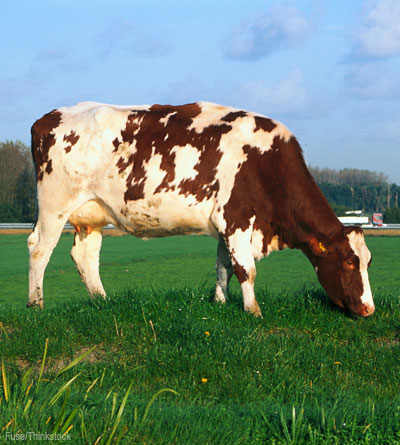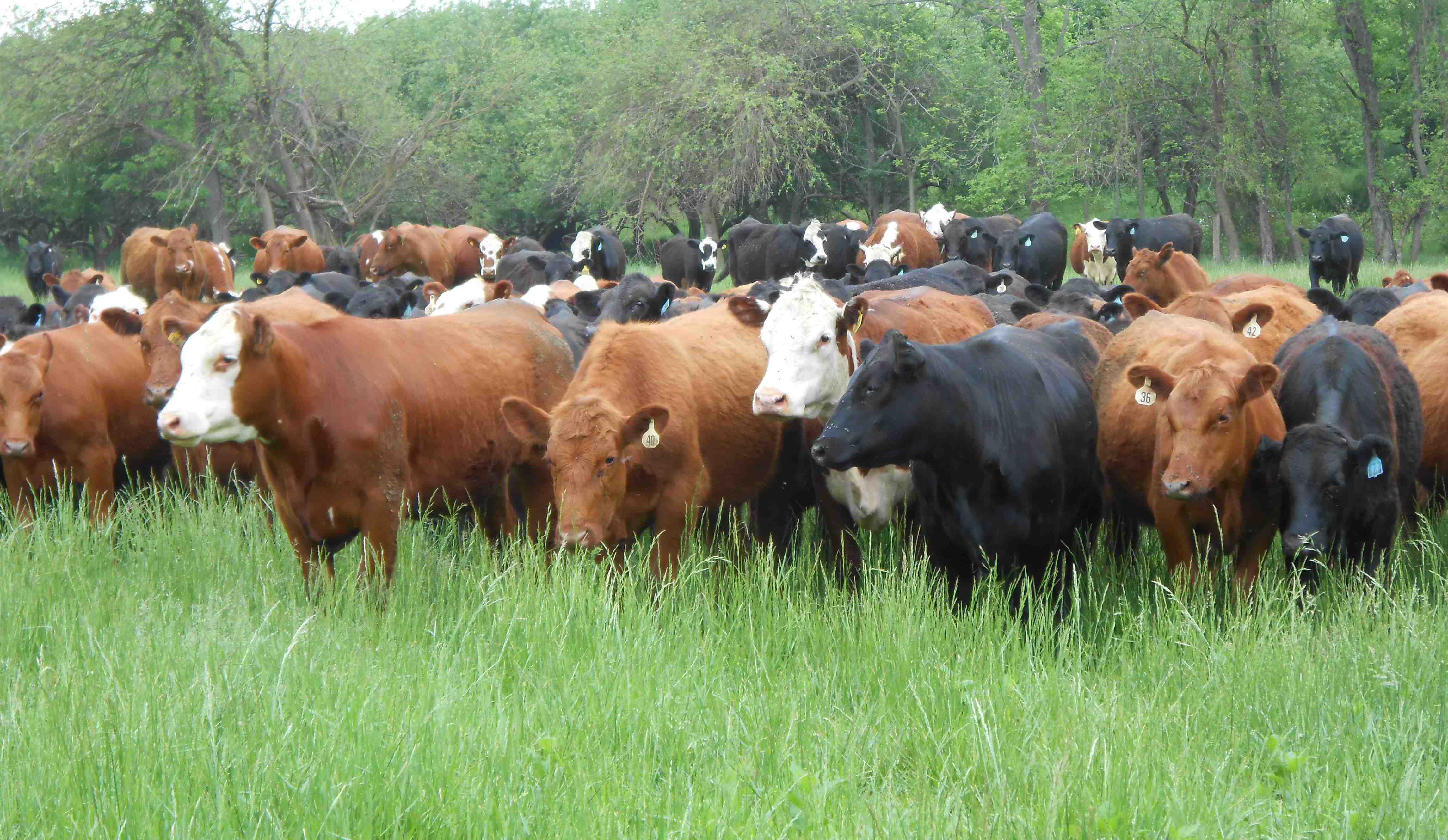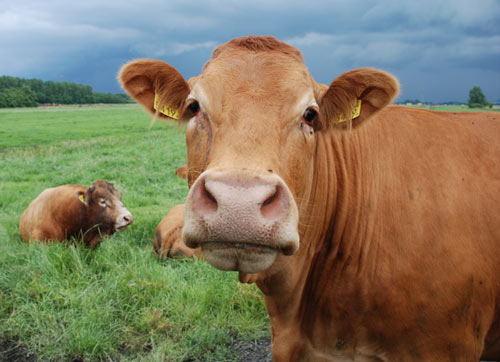
Cattle, buffalo, and bison belong to the Bovidae
family of oxenlike animals. Cattle include
both the humpless Bos taurus (comprising the socalled
European breeds) and the humped Bos
indicus (known as Zebu cattle); both are of the
same species in that they are fully interfertile. Buffalo,
or Asiatic or water buffalo, include the river
buffalo and swamp buffalo. Bison come in three
varieties (interfertile and hence of the same species),
namely the European wood bison, the
American plains bison, and the American wood
bison; while the latter two are commonly referred
to as buffalo, they are actually more closely related
to cattle than to the Asiatic buffalo. Cattle, Asiatic
buffalo, and bison constitute three of the five genera
in this family, the other two being the African
buffalo (Syncerus caffer) and the yak (Poephagus
grunniens), although the latter is sometimes classified
in the same genus as cattle (Bos).
All are herbivores, dependent solely on plant
material for their nutrition. Furthermore, they are
ruminants, having the ability to rapidly ingest
their food and to subsequently regurgitate and
rechew it. The first of their four stomach compartments,
the rumen, is used for microbial fermentation
of plant material, some of which would not
otherwise be digestible. All the animals are fourfooted
and have split hooves. Both male and female
have horns, except for those with a genetic
variation leading to polled (hornless) animals.
They have a keen sense of smell, and good sight
and hearing. They are herd animals and generally
produce a single offspring annually; when nutritionally
or metabolically stressed, they may calve
every other year. They usually give birth in the
spring, except for intensively managed cattle,
which can do so year-round.
Cattle evolved on the plains and forests of Europe
and Asia. Bos taurus was first domesticated in
the Fertile Crescent 6000 b.c.e. and Bos indicus independently
in south Asia, probably India, about
one thousand years later. They were likely first
domesticated for religious purposes, and they are
still considered sacred in India. They subsequently
were developed for work (such as pulling carts
and riding), milk, and meat. Their hides were
used for shelter and clothing. In addition, their
manure is used for fertilizer and, when dried, for
fuel. Currently, they are the most numerous livestock
species in the world, numbering 1.3 billion,
and are found in most areas of the world, except
Antarctica. Depending on the breed and nutrition,
mature males weigh between 1,000 and 3,000
pounds (450 to 1,350 kilograms).Worldwide, cattle
produce 85 percent of the milk consumed by
humans. In developed countries, cattle have been
highly selected for milk or meat production, leading
to specialized breeds. Holstein-Friesian is the
primary dairy cattle breed, while Hereford, Angus,
and Brahman are three well-known beef cattle
breeds; the latter is a Bos indicus breed. Various
crossbred and regional varieties exist. The transportation
of feed grains permits cattle to be raised
in areas that would otherwise not support them.
The Asiatic buffalo evolved in the forests and
swamps of south and east Asia. It was also probably
domesticated in two locations, the river buffalo
on the Indian subcontinent 3000 b.c.e. and the
swamp buffalo in east or southeast Asia about one
thousand years later. Depending on the breed and
nutrition, the mature male buffalo can weigh up to
two thousand pounds (nine hundred kilograms).
It lacks ahumpand a dewlap. Like cattle, it is used
for work, meat, milk, clothing, fertilizer, and fuel.
While most of the world's 150 million buffalo
are still found in Asia, some are
around the Mediterranean (Italy
and Egypt), in eastern Europe (Romania,
Bulgaria, and Russia), Brazil,
and Australia. In the developing
world, its use as a work animal
is paramount, particularly in plowing
rice paddies. However, breeds
of river buffalo have been selected
for milk production and account
for fully half of the milk production
in India. Mozzarella cheese
was originally made from buffalo
milk in Italy, and the very best continues
to be so made.
The bison evolved in the colder
regions of Europe and Central
Asia; it came to North America
over a land bridge from Asia during
the last ice age. It was never
domesticated, in large measure because
of its unpredictable behavior,
including a tendency to stampede.
The European wood bison
was hunted nearly to extinction
and only survives in a few small
herds. After the last ice age and
the demise of mammoths, the bison
was the largest animal in the
Western Hemisphere; the mature
male weighs around two thousand
pounds (nine hundred kilograms).
In 1500 c.e., over forty million bison
roamed the plains and woods
of North America. The Plains Indians depended on the bison for food, shelter, clothing,
and fuel. With the completion of the transcontinental
railroad, the American bison was
decimated for meat, hide, sport, and sometimes
no apparent reason. By the end of the nineteenth
century, fewer than one thousand survived. However,
conservation efforts by the American Bison
Society were successful and today over 200,000
animals are found in hundreds of herds, including
twenty-five with more than 500 animals each. The
Bronx Zoo was particularly important in preserving
seventy-seven animals from five founding
herds, fromwhich most American bison today are
descended.
Comparison of Cattle and Buffalo
Compared to cattle, the Asiatic buffalo is bigboned,
massive, and set on strong legs with large
hooves. It can pull heavier loads, but is slower. It is
better suited to muddy conditions because of its
larger hooves and lower susceptibility to foot rot;
accordingly, it is much more useful in working
flooded rice paddies. On the other hand, its
hooves are softer; if used extensively on hard surfaces,
it must have its hooves protected by metal
plates, wooden shoes, or straw pads. Perhaps surprisingly
in view of its origin in the hot and humid
areas of Asia, the buffalo is more susceptible to
heat stress because of its limited sweat glands. It is
best worked in the early morning or evening and
must have access to water or mud to wallow in
and dissipate heat. It is not tolerant of cold because
it lacks hair and the added insulation it
provides. It is relatively slow growing and, hence,
is not as efficient as a producer of meat. Under
similar environments and management in the
Third World, buffalo and cattle produce similar
amounts of milk. In the developed world, the milk
production of buffalo is much lower, probably because
of the greater genetic selection that has been
practiced on dairy cattle. Its hide is very thick and
tough; this appears to provide some protection
from tick-borne diseases. The disposition of
swamp buffalo, especially, is very placid, with its
care often entrusted to children. However, it does
have a strong hunger reflex and requires heavier
fencing than cattle generally do.
Comparison of Bison with Cattle and Buffalo
Compared with cattle and the Asiatic buffalo, the
bison has never been domesticated. However, it
can be farmed, and around 90 percent of the animals
are currently in private herds. Compared
with cattle and buffalo, it is the most homogeneous
in terms of color, with mature animals often
a dark brown, although a few white bison do occur.
While it will charge to defend itself, its preferred
defense is to run; it can maintain a speed of
thirty-five miles per hour (fifty-six kilometers per
hour) for half an hour. Because of its hardiness, it
can survive severe winters, with temperatures
down to -50 degrees Fahrenheit (-45 degrees Celsius).
It is easily more cold tolerant than the buffalo
and even most cattle. It is susceptible to many
diseases that affect cattle, specifically brucellosis,
which causes abortions in cattle and undulant fever
in humans. Controlling the disease in wild animals
is more difficult than in cattle. Accordingly,
it is important to keep bison and cattle separate
unless both are known to be brucellosis-free. Bison
require sturdier fencing than do cattle and
probably buffalo.
Cattle, Buffalo, and Bison Facts
Classification:
Kingdom: Animalia
Subkingdom: Bilateria
Phylum: Chordata
Subphylum: Vertebrata
Class: Mammalia
Order: Artiodactyla
Suborder: Ruminantia
Family: Bovidae (oxenlike animals)
Genus and species: Bos primigenius, also known as Bos taurus or
Bos indicus (cattle); Bubalus bubalis (Asiatic or water buffalo),
B. depressiicornis (lowland anoa), B. quarlesi (mountain anoa),
B. mindorensis (tamarau); Bison bonasus (European wood bison),
B. bison (American bison)
Geographical location: Cattle-originally the plains of Europe
and Asia, currently worldwide, except for Antarctica; buffalo-
mostly south and east Asia; bison: plains and prairies of North
America
Habitat: Cattle-grasslands; buffalo-tropical and subtropical
forests, swamps, or grasslands; bison-temperate grasslands
Gestational period: Cattle-nine months; buffalo-ten to eleven
months; bison-nine to ten months
Life span: Up to twenty-five years, depending on management
Special anatomy: Cattle-may have a hump over the shoulders
and a dewlap (B. indicus) or neither (B. taurus); buffalo-a thick
hide, which makes it resistant to some disease-carrying insects;
few sweat glands, necessitating wallowing in water or mud in
hot environments; breeds exhibit a wide variety of horns; bison-
large head and a hump over the shoulders; two layers of
hair, a dense undercoat and a coarser outercoat, hardy and able
to withstand cold winters; a Jacobson's organ on the roof of the
mouth to enhance its sense of smell
Other popular Animals
Photo Gallery of - Cattle, Buffalo, and Bison








 Animalia Life
Animalia Life